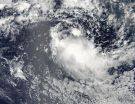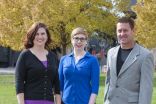(Press-News.org) ANN ARBOR, Mich. - Most parents agree their children should be ready to move out of the pediatrician's office into adult-focused care by age 18 - but just 30 percent actually make that transition by that age, according to the University of Michigan C.S. Mott Children's Hospital National Poll on Children's Health.
As health care becomes more complex, it's difficult for teens to shift from relying on their parents to taking on their own health care needs.
The C.S. Mott National Poll on Children's Health asked a national sample of parents of adolescents and young adults aged 13-30 years old about their perceptions of their children's abilities to manage their health care.
The poll found that about two-thirds of parents (69%) believe adolescents should stop seeing their child-focused provider and begin seeing an adult-focused provider for primary care at age 18 (42%), or even at younger ages (27%).
However, only about one-third (30%) of parents of 18- to 30-year-olds reported that their adolescents actually transferred to adult care by age 18.
"Making this transition is something virtually all teens and young adults will have to do, but this poll makes it clear that many parents are doubtful that their kids are ready to make the leap at age 18," says Emily Fredericks, Ph.D., associate professor of pediatrics at C.S. Mott Children's Hospital and the U-M Medical School. Fredericks is also a faculty member in the Child Health Evaluation and Research (CHEAR) Unit at the University of Michigan, in the Department of Pediatrics and Communicable Diseases.
Parents were mostly confident about adolescents and young adults knowing how to take medications, Fredericks says, but that confidence dropped substantially when they were asked about knowing when to go to the ER, filling out medical history forms, or knowing how to make a doctor's appointment.
"Less than half of parents think their older teens, 18 to 19 years old, know how to make a doctor's appointment, and only one-quarter of parents believe their teens know what their health insurance covers," Fredericks says.
"This perceived lack of skills may explain why so few teens transition their care by age 18. Parents may realize that becoming an adult at age 18 is not a guarantee that their young adult is suddenly ready to manage their own health care."
As young adults are preparing to make the transition to adult-focused care, Fredericks says, there are some things parents can do.
Parents can encourage teens to play more of a role in the process of seeking health care, like calling the doctor's office, asking and answering questions during the visits and learning about what is covered by health insurance, she says.
"Age alone shouldn't be the only factor. Instead, parents and healthcare providers can partner with adolescents to gradually teach them the self-management skills they need to successfully navigate the healthcare system," Fredericks said. "Our poll results indicate that transition needs to be a learning process, not a point in time where suddenly teens are ready to be independent when it comes to their health."
INFORMATION:
Broadcast-quality video is available on request. See the video here:
https://www.youtube.com/watch?v=7BxlbVbJzs4
Full report: C.S. Mott Children's Hospital National Poll on Children's Health
http://mottnpch.org/reports-surveys/many-parents-doubt-their-older-teens-are-ready-manage-their-own-health-care
Additional Resources:
Got Transition?: http://www.gottransition.org
Adolescent Health Transition Project: http://depts.washington.edu/healthtr/
Hospital for SickKids Good 2 Go Program: http://www.sickkids.ca/good2go/
Website: Check out the Poll's website: MottNPCH.org. You can search and browse over 90 NPCH Reports, suggest topics for future polls, share your opinion in a quick poll, and view information on popular topics. To share feedback, e-mail NPCH@med.umich.edu.
Facebook: http://www.facebook.com/mottnpch
Twitter: @MottNPCH
Purpose/Funding: The C.S. Mott Children's Hospital National Poll on Children's Health - based at the Child Health Evaluation and Research Unit at the University of Michigan and funded by the Department of Pediatrics and Communicable Diseases and the University of Michigan Health System - is designed to measure major healthcare issues and trends for U.S. children.
Data Source: This report presents findings from a nationally representative household survey conducted exclusively by GfK Custom Research, LLC (GfK) for C.S. Mott Children's Hospital via a method used in many published studies. The survey was administered in June 2014 to a randomly selected, stratified group of adults with a child 13-30 (n=887), from GfK's web-enabled KnowledgePanel®, that closely resembles the U.S. population. The sample was subsequently weighted to reflect population figures from the Census Bureau. The survey completion rate was 53 percent among panel members contacted to participate. The margin of error is ±5 to 9 percentage points and higher among subgroups.
Findings from the U-M C.S. Mott Children's Hospital National Poll on Children's Health do not represent the opinions of the investigators or the opinions of the University of Michigan.
Cities like Miami are all too familiar with hurricane-related power outages. But a Johns Hopkins University analysis finds climate change will give other major metro areas a lot to worry about in future storms.
Johns Hopkins engineers created a computer model to predict the increasing vulnerability to hurricanes of power grids in major cities on or relatively near the Atlantic and Gulf coasts. They factored historic hurricane information in with plausible scenarios for future storm behavior, given a global rise in average temperatures. With that data, the team could pinpoint ...
Monstrous moonshine, a quirky pattern of the monster group in theoretical math, has a shadow - umbral moonshine. Mathematicians have now proved this insight, known as the Umbral Moonshine Conjecture, offering a formula with potential applications for everything from number theory to geometry to quantum physics.
"We've transformed the statement of the conjecture into something you could test, a finite calculation, and the conjecture proved to be true," says Ken Ono, a mathematician at Emory University. "Umbral moonshine has created a lot of excitement in the world of math ...
By blocking a widespread enzyme, Centenary researchers have shown they can slow down the movement of cells and potentially stop tumours from spreading and growing.
Using a new super-resolution microscope they've been able to see single molecules of the enzyme at work in a liver cancer cell line. Then they've used confocal microscopes to see how disrupting the enzyme slows down living cancer cells.
The enzyme is DPP9 (dipeptidyl peptidase 9) which the researchers at the Centenary Institute and the Sydney Medical School were first to discover and clone, in 1999. Ever ...
Tropical Cyclone Bakung is moving in a westerly direction over the open waters of the Southern Indian Ocean and NASA's Aqua satellite captured an image of the sea storm.
Aqua passed over Bakung on Dec. 12 at 07:35 UTC (2:35 a.m. EST) and the MODIS instrument aboard took a visible image of the storm. The image showed that deeper convection (stronger currents of rising air that form the thunderstorms that make up the tropical cyclone) was occurring around the low-level center of circulation, so the center was not apparent in the MODIS imagery. The bulk of the clouds associated ...
Natural gas from hydraulic fracturing generates income and, done well, can reduce greenhouse gas emissions, air pollution and water use compared to coal and even nuclear energy. However, widespread use of natural gas from fracking could slow the adoption of wind, solar and other renewables and, done poorly, release toxic chemicals into the environment.
Robert Jackson, the Kevin and Michelle Douglas Professor of Environment and Energy at the Stanford School of Earth Sciences, will discuss how to minimize the water and air impacts of fracking and other unconventional energy-extraction ...
Recent international climate talks have focused on the potential of reforestation and afforestation - planting trees in an area where there was no forest previously - to slow global warming. Increasingly, though, science is showing that planting more trees and increasing forest conservation can provide benefits beyond carbon storage, and that carbon-centric accounting is, in many cases, insufficient for climate mitigation policies.
Robert Jackson, the Kevin and Michelle Douglas Professor of Environment and Energy at the Stanford School of Earth Sciences, will discuss ...
Runoff from rainstorms in big cities can represent both threats and opportunities. Too much runoff in the wrong places causes flooding. Too little rainwater in the right places leads to dried-up creeks and rivers. Water that washes up pollution from city streets can dirty downstream watersheds. Figuring out the best solutions to these problems requires lots of data - data that are easy to get in highly developed countries, but much scarcer in others.
On Dec. 15 at the American Geophysical Union Fall Meeting in San Francisco, Perrine Hamel, a postdoctoral scholar with ...
Stanford scientists have found evidence that sections of the fault responsible for the 9.0 magnitude Tohoku earthquake that devastated northern Japan in 2011 were relieving seismic stress at a gradually accelerating rate for years before the quake.
This "decoupling" process, in which the edges of two tectonic plates that are frictionally locked together slowly became unstuck, transferred stress to adjacent sections that were still locked. As a result, the quake, which was the most powerful ever recorded to hit Japan, may have occurred earlier than it might have otherwise, ...
WASHINGTON, Dec. 15, 2014--Credit card fraud and identify theft are serious problems for consumers and industries. Though corporations and individuals work to improve safeguards, it has become increasingly difficult to protect financial data and personal information from criminal activity. Fortunately, new insights into quantum physics may soon offer a solution.
As reported in The Optical Society's (OSA) new high-impact journal Optica, a team of researchers from the Netherlands has harnessed the power of quantum mechanics to create a fraud-proof method for authenticating ...
A survey of more than 300 college students reveals that college students who use "fake weed" or synthetic THC are most likely to have tried the drug because they were curious. Rebecca Vidourek, a University of Cincinnati assistant professor of health promotion and assistant director of the Center for Prevention Science; Keith King, a UC professor of health promotion and director of the Center for Prevention Science; and Michelle Burbage, a graduate student and graduate assistant for UC's Health Promotion and Education Program, published their findings in the current issue ...



